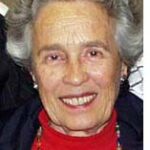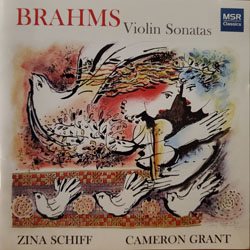Here is another in Eileen Wingard’s series on the discography of her sister, concert violinist Zina Schiff.

 SAN DIEGO — I was delighted when my sister, violinist Zina Schiff, and Cameron Grant, solo pianist with the New York City Ballet, recorded the three Brahms Sonatas for Violin and Piano, released by MSR Classics, because Johannes Brahms (1833-1897) is my all-time favorite composer. The bittersweet nature of his music, the Hungarian Gypsy tunes, the waltz-like rhythms, the syncopations, all spoke to me and touched my heart.
SAN DIEGO — I was delighted when my sister, violinist Zina Schiff, and Cameron Grant, solo pianist with the New York City Ballet, recorded the three Brahms Sonatas for Violin and Piano, released by MSR Classics, because Johannes Brahms (1833-1897) is my all-time favorite composer. The bittersweet nature of his music, the Hungarian Gypsy tunes, the waltz-like rhythms, the syncopations, all spoke to me and touched my heart.
Perhaps my love for Brahms’ music began when I was a young child and my mother sang his Lullaby to lull me to sleep. Or perhaps it was when I listened to my trio partner in high school play one of Brahms’ passionate piano ballades, or when I heard Zvi Zeitlin perform the Violin Sonata No. 3 in recital, or when I played Brahms’ symphonies in the various orchestras in which I participated, including the San Diego Symphony Orchestra.
As a student in the Music Department at UCLA, I remember enrolling in a special elective class on Brahms, offered by the music reviewer of the Los Angeles Times, Albert Goldberg. During the time I was a Fulbright Scholar in Germany, when we visited Hamburg, the first place I wanted to see was Brahms’ house. It was a small, exposed-beam, two-story, tucked between two other row houses on a crowded street. It reflected his modest circumstances during his formative years as middle child of a seamstress mother and a string bass player father. At an early age, the talented boy had to help with family finances by playing in inns and brothels.
When my husband and I were vacationing in the Black Forest in 2005, one of the highlights was our trip to Baden-Baden, where we visited Brahms’ apartment, now a museum, the Brahmshaus. One room was filled with memorabilia of Brahms and the other, filled with that of Clara Schumann. They both spent summers there during the years between 1863-1873. From the window, we could look out on the street where Clara and her children lived, and where Brahms would join them every day for Mittagsessen (lunch). Also visible was the church where Brahms escorted Clara’s daughter down the aisle for her wedding.
The Hungarian-Jewish violinist, Joseph Joachim, for whom Brahms composed his violin works, recognized Brahms’ talent and introduced him to Clara and Robert Schumann in Dusseldorf. After meeting Brahms, Robert championed the young composer in his Neue Zeitschrift fuer Musik. When Robert attempted suicide and was committed to a sanatorium, where the doctors prohibited Clara from visiting, Brahms acted as a go-between. During Robert’s illness and after his death, the friendship between Clara and Johannes deepened.
The three sonatas were composed while Brahms was enjoying the beauty of nature. The first was while he was at Portschah-am-See, the second, while at Lake Thun, in Switzerland, and the third, while in the Swiss Alps. He inserts themes from some of the songs he had previously written. Of these sonatas, Brahms’ biographer, Jan Swafford, wrote that they “seem to voice a lyrical, romantic evocation.”
Brahms called his friendship with Clara, “the most beautiful experience of my life, its greatest wealth and noblest content.” Clara stated, “I have never loved a friend as I loved him; it is the most beautiful mutual understanding of two souls.”
Zina concludes her CD liner notes: “his lifelong love for Clara endures in the eloquence of his music.”
This recording received unanimous critical praise.
Gramaphone Magazine lauded how the performers “emphasize the subtle poetry that pervades these scores…It is a glorious performance.”
The Audio Society of Atlanta called it, “a stunning beauty.”
The three excerpts from this Brahmsian feast are: The first movement, Vivace ma non troppo from Sonata No. 1 in G major (track 1), the second movement, Andante tranquillo, from Sonata No. 2 in A major (track 5), and the final movement, Presto agitato from Sonata No. 3 in D minor (track 10).
*
Eileen Wingard, a retired violinist with the San Diego Symphony Orchestra, is a freelance writer specializing in the coverage of the arts. She may be contacted via eileen.wingard@sdjewishworld.com